Physical Address
304 North Cardinal St.
Dorchester Center, MA 02124
UNAIDS estimates that globally 36.7 million people, including 2.1 million children, were living with human immunodeficiency virus (HIV) infection in 2016. The number of people who acquired HIV infection in 2016 was 1.8 million. Since the start of the epidemic, 35 million people have died of acquired immune deficiency syndrome (AIDS)-related illnesses. Tuberculosis is still the leading cause of death in people living with HIV; however, deaths due to AIDS have fallen by 48% since their peak in 2005. Access to antiretroviral therapy (ART) is increasing, and an estimated 19.5 million people with HIV infection were receiving ART in 2016.
HIV is an enveloped RNA virus belonging to the genus Lentivirus within the family Retroviridae . The disease-causing viruses are HIV-1 and HIV-2, which result in a decline in CD4 T lymphocytes. HIV-2 is detected mainly in West Africa. Both HIV types cause a similar clinical disease profile. HIV-2, however, is associated with a reduced rate of transmissibility, more gradual decline in CD4 T lymphocytes, and clinical progression. HIV enters cells via CD4 and the chemokine co-receptors CCR5 and CXCR4. The lack of natural eliminatory mechanisms of HIV following primary infection and continued viral replication throughout the course of the disease are pivotal to the initiation, establishment, and propagation of HIV infection.
In a Danish population-based study, adults with both skin infections and ‘skin diseases’ were significantly more likely to be diagnosed with HIV infection in the subsequent 5 years compared to individuals without. More than 90% of HIV-infected individuals will develop one or more dermatological disorders during the course of their illness, either as a result of AIDS or due to the effects of treatment. Furthermore, cutaneous disease is often the first manifestation of undiagnosed HIV infection or AIDS.
Late diagnosis is significantly related to HIV associated morbidity and mortality in the UK. The British HIV Association and the US Centers for Disease Control and Prevention (CDC) recommend offering and encouraging patients to have an HIV test in a wide variety of clinical settings.
A wide variety of skin diseases may arise in concert with or be modified by the progressively declining CD4 lymphocyte count. HIV infection should always be suspected when the clinical history reveals that a common skin disorder has presented with atypical clinical features, followed an abnormal clinical course, displayed greater clinical severity than anticipated, or failed to exhibit a satisfactory clinical response to standard therapy for that particular condition. The spectrum of cutaneous HIV disease includes AIDS-defining opportunistic infections and neoplasms (summarized at the end of the chapter and discussed in depth elsewhere in the book), drug-induced cutaneous manifestations, and a range of noninfectious dermatoses that may occur in all stages of HIV progression. This latter group comprises dermatoses peculiar to HIV infection (e.g., acute HIV exanthem, pruritic papular eruption), those occurring with greater frequency or modified by HIV/AIDS (e.g., seborrheic dermatitis, psoriasis), and a variety of less common conditions in which an association with HIV infection has been reported (e.g., cutaneous manifestations of reactive arthritis, pityriasis rubra pilaris). HIV-positive patients may present with more than one skin disorder, a fact of which the practicing histopathologist should always remain cognizant when examining skin biopsies in this clinical context.
In resource-limited settings, malnutrition is commonly associated with HIV infection and is difficult to manage. Noma (cancrum oris) has been reported in HIV-infected children and adults in Africa and beyond.
Immune reconstitution inflammatory syndrome (IRIS) may present with cutaneous manifestations of infections or inflammatory dermatoses.
This chapter focuses on the acute exanthema of HIV, papulosquamous, photosensitivity, pruritic papular, vasculitic, and autoimmune bullous dermatoses that may be associated with HIV infection.
Symptomatic primary or acute HIV infection, which occurs in more than 95% of HIV-infected patients, is often heralded by a mononucleosis-like illness with fever, lymphadenopathy, sore throat, myalgia, arthralgia, malaise, and an exanthem. The rash is of varied morphology and occurs in approximately 60% of patients. It may be a macular exanthem with roseola-like features, or maculopapular with hemorrhagic and necrotic lesions ( Fig. 19.1 ). There is a painful erosive enanthem in 25% of cases. There may be vesicles, urticaria, alopecia, genital ulceration, and Stevens-Johnson syndrome. The mean duration of symptoms is 10 days and resolves spontaneously. The triad of a maculopapular rash with oral and genital ulcers should raise suspicion of acute HIV infection.
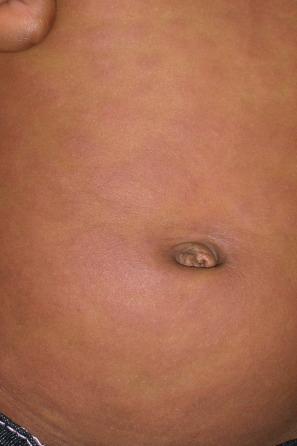
CD1a intraepidermal Langerhans cells are significantly decreased. Individual Langerhans cells that express HIV-p24 antigen are seen in close apposition to cytotoxic T cells. Dendritic cells are the putative virus reservoir, and the skin is a major site of HIV replication during the course of the disease.
The histopathologic alterations are not specific. Early macular and papular lesions of HIV exanthem demonstrate dermal inflammatory changes without epidermal alterations ( Figs 19.2 and 19.3 ). With progression, there is confluent epidermal parakeratosis, as well as isolated and aggregated keratinocyte necrosis with associated satellite lymphocytes ( Fig. 19.4 ). Basal layer vacuolar change, keratinocyte ballooning degeneration, exocytosis, upper dermal colloid bodies, and pigmentary incontinence are variably present ( Fig. 19.5 ). A perivascular, periadnexal, and interstitial lymphohistiocytic inflammatory infiltrate, with a predominance of CD4-positive T lymphocytes, is present in the papillary and upper and mid-reticular dermis. Similar changes may be seen in hair follicle epithelium. Advanced papular or papulovesicular lesions demonstrate spongiosis, intraepidermal vesicles, or ballooning degeneration.
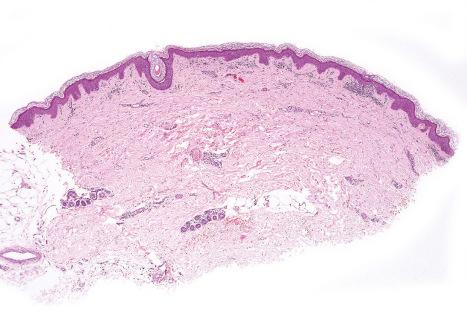
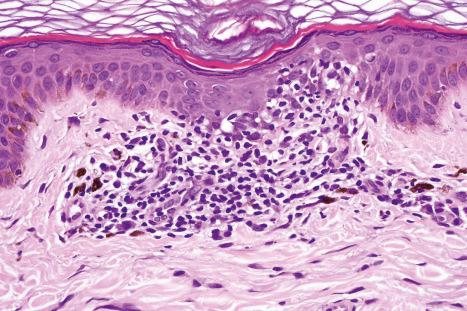
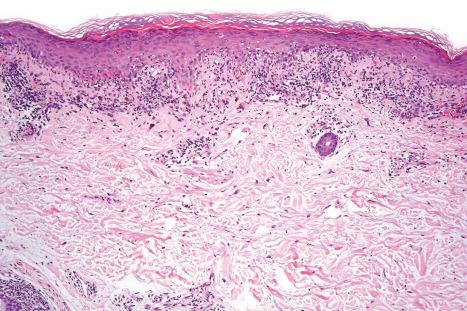
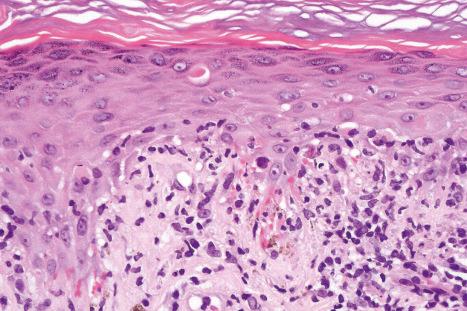
The history of a seroconversion illness is critical as the spectrum of histologic changes encountered in chronic HIV interface dermatitis induced by drugs and lichenoid HIV photoeruptions may overlap with that of acute HIV exanthem.
Seborrheic dermatitis is the most common cutaneous disease to affect HIV-infected patients and often occurs early on in HIV infection or it may reflect disease progression. It is seen in up to 85% of all HIV-infected individuals at some stage during the course of their disease. Although seborrheic dermatitis is characterized by erythema and greasy scaling of the nasolabial and postauricular areas, eyebrows, external ears, and scalp, as is seen in the general population, it can be more widespread, involving the chest, trunk, groin, and extremities with progression to erythroderma in those with HIV infection. Other HIV-associated clues of seborrheic dermatitis include a predominance of inflammatory and hyperkeratotic lesions, papular and scaly plaquelike lesions resembling psoriasis, hypo- and hyperpigmentation, a ‘cradle cap’ appearance of the scalp, and a sudden onset or acute worsening of seborrheic dermatitis.
The exact pathogenesis of HIV-associated seborrheic dermatitis is not known. A relationship with AIDS-associated dementia and central nervous system disease has nevertheless been documented in 20% of AIDS patients and in HIV-negative patients with neurological diseases. HIV-1 possesses neurotropic characteristics. It has therefore been proposed that the same mechanism promoting seborrheic dermatitis in neurological diseases occurs in HIV. Seborrheic dermatitis is sometimes associated with Malassezia furfur infection, but the exact role has not been clarified.
The histologic features include those seen in seborrheic dermatitis in HIV-negative patients, including hyperkeratosis, parakeratotic mounds localized particularly to the ostia of hair follicle infundibula, acanthosis with regular elongation of the rete ridges, and mild spongiosis with intraepidermal lymphocytes and neutrophils. Features specific for AIDS-related seborrheic dermatitis include spotty keratinocyte necrosis, hyperkeratosis, leukocytic exocytosis, a perivascular plasma cell infiltrate in the dermis, and focal leukocytoclasis.
The overall incidence of HIV-associated psoriasis does not appear to exceed that of the general population. Occurring in 1% to 3% of HIV-infected individuals, the spectrum of clinical manifestations may be similar to psoriasis in the non-HIV-exposed group. Psoriasis may be the first clue to HIV infection and may undergo remission with advanced disease. Although all degrees of severity of psoriasis may occur at any stage of HIV infection, there may be deterioration with worsening immunosuppression. Pre-existing psoriasis may undergo severe exacerbation with HIV infection ( Figs 19.6 and 19.7 ). Patients may present with classic signs of psoriasis, rupioid lesions, sebopsoriasis, erythrodermic psoriasis, or a combination of lesions of various morphologies.
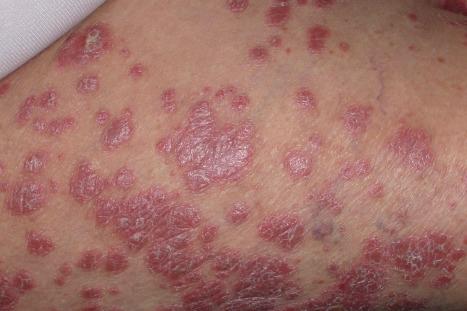
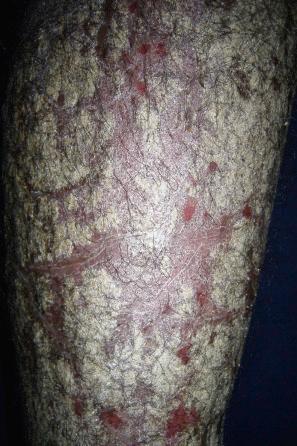
The pathogenesis of HIV-induced psoriasis is complex. Psoriasis is considered to be a T-helper-1 dominant disease. The milieu of cytokines includes interleukin-17 produced by CD4+ T lymphocytes, which seems incongruous in the context of psoriasis in HIV. Immune dysregulation is postulated to play a pivotal role in HIV-associated psoriasis. HLA-Cw6 is the most frequently described genetic factor in association with psoriasis. A significantly higher proportion of patients with HIV-associated psoriasis carry the HLA-Cw*0602 allele. It has been suggested that immune dysregulation may activate microorganisms to trigger psoriasis in predisposed patients carrying the Cw*0602 allele. This allele is postulated to be a putative target for CD8+ T lymphocytes responding to processed peptides from microorganisms, via molecular mimicry. A study showed a significant association between a CD4 count of < 200 × 10 6 /L and the evolution of psoriasis in HIV-positive patients.
The histologic spectrum of HIV-associated psoriasis is similar to that of psoriasis vulgaris, but the dermal infiltrate contains fewer T lymphocytes and significantly more plasma cells ( Figs 19.8–19.10 ).
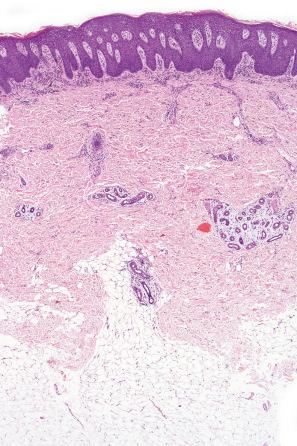
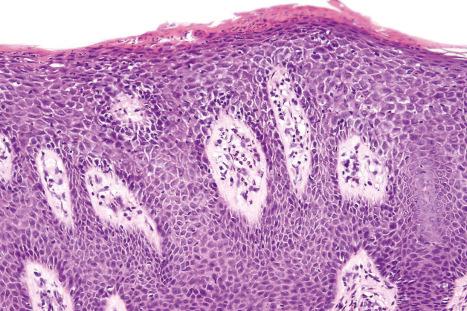
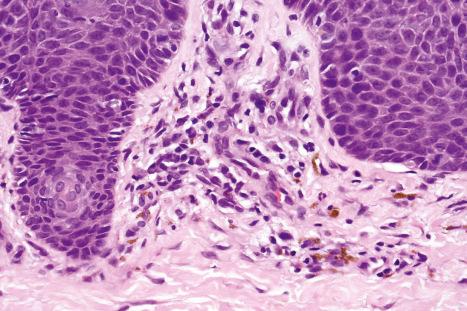
HIV-associated pityriasis rubra pilaris (PRP), also referred to as pityriasis rubra pilaris type VI (PRP-VI), is characterized by cutaneous lesions of PRP, and variable association with acne conglobata, hidradenitis suppurativa, and lichen spinulosus. Although PRP-VI is a disease usually encountered in young adults, children may be afflicted. It occurs predominantly in males and may be the sentinel of HIV infection. Clinically, PRP-VI is characterized by pruritic, symmetrical, erythematous, desquamative follicular papules that tend to become confluent, frequently resulting in erythroderma. The eruption occurs mainly over the extensor surfaces. There is variable palm and sole keratoderma, scalp scaling, and nail hyperkeratosis. The CD4 cell count is highly variable, ranging from values as low as 8 cells/mm 3 to > 1000 cells/mm 3 . Patients with higher CD4 counts (> 500 cells/mm 3 ) may suffer fatal PRP complications. Improvement of PRP (and the associated hidradenitis suppurativa) following the institution of ART has been reported.
Although the association between HIV infection and PRP seems clear, the exact pathogenetic mechanisms involved are unknown. A direct role for HIV has been proposed because of the association with HIV and the response to ART. Infection of the follicular hair bulge by HIV and secondary follicular inflammation have been suggested, as has precipitation of PRP in genetically predisposed individuals. The coexistence of PRP, acne conglobata, and follicular plugging was a rare occurrence prior to HIV. The overlapping histologic features have heralded the possibility that the spectrum of clinicopathological features may be due to a single disorder of follicular keratinization. PRP-VI may therefore be part of a unique and distinctive disease, more appropriately placed under the wider rubric of HIV-associated follicular syndrome.
Histologically, there is variable epidermal psoriasiform hyperplasia and lamellar hyperkeratosis, with alternating zones of vertical and horizontal parakeratosis and an intact granular cell layer ( Figs 19.11 and 19.12 ). There is follicular hyperkeratosis and variable infundibular dilation with orthokeratotic and hyperkeratotic keratin. A sparse mononuclear infiltrate is present around the superficial vascular plexus and hair follicles. Perifollicular mucinosis may be present.
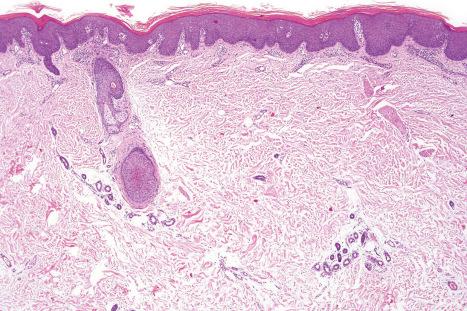
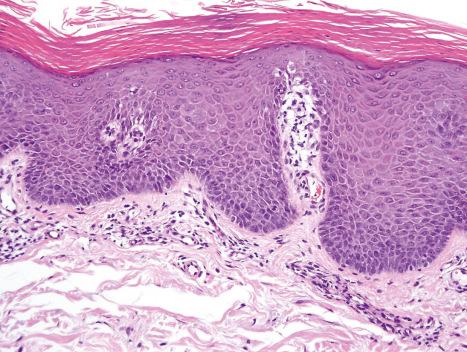
Xerosis is common in HIV infection, occurring at any time throughout disease progression but significantly associated with lower CD4 counts and the ART drug indinavir. Xerosis is often pruritic but less so than other HIV associated dermatoses. Xerotic dermatitis was reported by 42.1% of men and 51.5% of women infected with HIV in the FRAM study. It is characterized by diffuse dryness of the skin with hyperpigmented scales and focal crusting ( Fig. 19.13 ). It is often prominent on the extremities and is worse in the winter months. Affected skin may fissure, leading to eczema craquelé and secondary infection in some patients. Occasionally, discrete thickened patches occur.
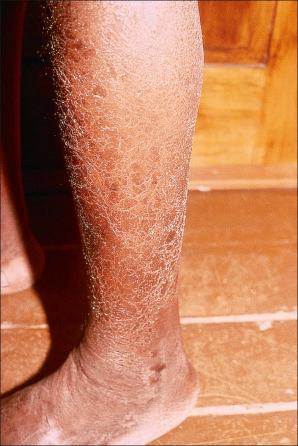
The pathogenesis of xerosis, although obscure, may be related to a range of factors, including cutaneous microcirculation and nutritional alterations, altered sweat or sebaceous gland activity, alterations in the composition of sweat, and changes in the cutaneous mast cell population. Decreased calcitonin gene-related peptide and substance P levels have been documented in HIV-associated xerosis. Epidermal lipid content has been shown to be reduced in individuals with HIV. These factors may result in decreased epidermal integrity, with a resultant reduction in the effectiveness of the epidermal barrier.
Skin biopsies often demonstrate minimal superficial epidermal hyperkeratosis with parakeratosis, mild acanthosis, and focal spongiosis in the absence of microvesiculation ( Fig. 19.14 ). The dermis demonstrates a minimal perivascular lymphocytic infiltrate. An inconsistent finding is the presence of early alterations of acquired ichthyosis, characterized by dense orthokeratosis with a diminished granular cell layer and minimal inflammation. Other pruritic scaling dermatoses, such as scabies, dermatophytosis, and the ‘flaky skin’ appearance of kwashiorkor, are clinicopathological mimickers, as all of these conditions may occur in individuals with advanced HIV infection.
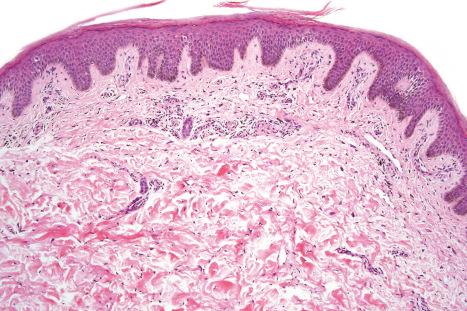
Photosensitivity refers to an abnormal response to nonionizing radiation. Photosensitivity is reported in more than 5% of individuals with HIV attending a specialized dermatology clinic.
The spectrum of photodistributed eruptions in HIV-infected patients includes porphyria cutanea tarda (PCT), granuloma annulare, hypertrophic lichen planus, erythroderma, chronic actinic dermatitis (CAD), photodistributed hyperpigmentation, and lichenoid photoeruptions. Some of the aforementioned conditions are discussed in further detail below.
Lichenoid photoeruptions are frequently seen as the CD4 cell count decreases and may be related to potentially photosensitizing drugs. The cutaneous disease may be persistent and extend to involve nonexposed areas and become generalized. Lower lip involvement may be present, but oral involvement is typically absent. CAD is associated with advanced HIV disease. Monochromator phototesting elicits reproducible sensitivity in the UVB range (290–320 nm). Vitiligo-like depigmentation may be encountered in some cases.
CAD is characterized by subacute dermatitis with variable psoriasiform dermatitis and an atypical lymphocytic infiltrate. The pathogenesis of CAD is unclear, but a delayed-type immune mechanism is postulated. The immune response in CAD appears regulated by CD8-positive T lymphocytes, which are thought to be reacting to a photoinduced antigen of endogenous origin. The role of HIV in this is unclear.
Histologically, lichenoid photoeruptions are characterized by marked hyperkeratosis, focal parakeratosis, acanthosis, papillomatosis, hydropic degeneration, and pigmentary incontinence ( Figs 19.15 and 19.16 ). There is variable keratinocyte necrosis with involvement of the upper half of the epidermis, a superficial perivascular infiltrate with a lichenoid pattern, and a mid to deep dermal infiltrate of mononuclear cells (including plasma cells) and eosinophils. Occasional features include a diffuse dermal infiltrate, wedge-shaped hypergranulosis, and a microscopic subepidermal blister.
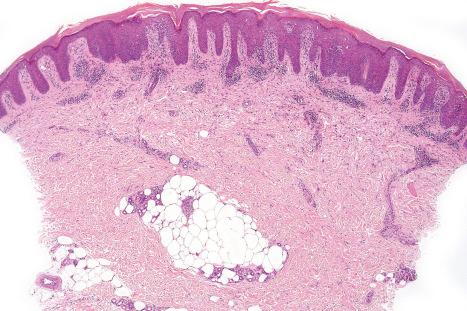
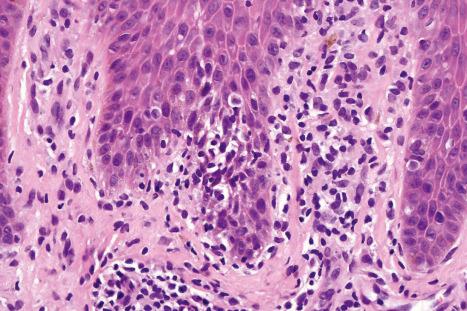
It has been postulated that the vitiligo-like depigmentation observed in some cases is potentiated by cytotoxic destruction of basal melanocytes by CD8+ lymphocytes.
HIV infection is associated with atypical forms of granuloma annulare (GA), including oral, perforating, and generalized forms ( Fig. 19.17 ). The generalized form occurs most frequently in HIV-infected patients. HIV-associated GA (HAGA) occurs predominantly in males, usually men who have sex with men, with an age range of 25 to 58 years. HAGA is characterized by a transient or chronic course and a more frequent occurrence on the extremities. A photodistributed generalized form of HAGA may occur.
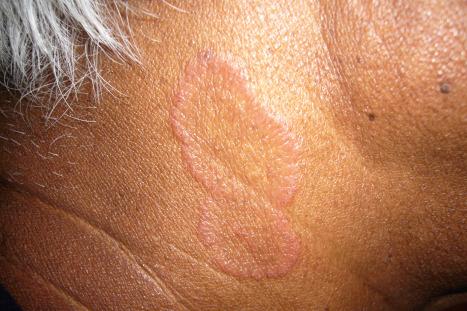
The exact pathogenesis of HAGA is uncertain. Polymerase chain reaction investigation and in situ hybridization have failed to confirm Epstein-Barr virus (EBV) as a causative agent. A type IV cell-mediated hypersensitivity reaction to an unknown antigen causing degenerative change has been proposed. The release of cytokines from activated fibroblasts and macrophages in GA has been proposed as the cause of degeneration of elastic tissue and collagen. Although immunophenotypic analyzes have demonstrated a CD4-positive T-helper cell response in most cases, similar to that in GA in HIV-negative patients, a predominant CD8-positive lymphocytic infiltrate may be present.
The histopathological picture is one of a necrobiotic granulomatous pattern that may be interstitial, palisaded, or mixed, similar to that in HIV-negative patients. Increased amounts of interstitial mucin can be demonstrated by Alcian blue or colloidal iron staining. The histologic changes in the incomplete (or interstitial) form of GA are often subtle.
Porphyria cutanea tarda (PCT) has been reported with increased frequency in HIV-infected patients; however, it is possible that this may be due to co-infection with hepatitis C virus (HCV). A study from Spain demonstrated that treatment of HCV in co-infected individuals resulted in resolution of PCT. The clinical signs of type 1 PCT, the sporadic form in which there is an acquired deficiency of uroporphyrinogen decarboxylase, are confined to the skin. Features include pruritic, fluid-filled vesicles, and bullae that develop in sun-exposed sites, including the face, dorsa of hands, and forearms. Additional findings include hyperpigmentation, hypertrichosis, and scarring.
The involvement of HIV in the pathogenesis of PCT is unclear because porphyrinogenic factors other than HIV such as alcohol use, drug therapy, and HCV infection have been identified in the majority of reported cases. The deposition of iron in the liver in patients consuming alcohol may be responsible for triggering PCT through direct inhibition of uroporphyrinogen decarboxylase activity. HIV may alter porphyrin metabolism through interference with the hepatic oxidase system or by creating ineffective erythropoiesis, which results in increased iron deposition. The altered steroid metabolism in patients with HIV infection could increase endogenous estrogen production, causing disruption of heme synthesis. Concomitant HIV and HCV infection increases HCV RNA levels, promoting clinical manifestations of PCT. The coexistent use of drugs may trigger PCT in the setting of HIV infection.
The histologic features are identical to those encountered in HIV-negative patients. Bullous lesions are characteristically cell-poor, with rigid papillary dermal capillary walls thickened by eosinophilic, PAS-positive material. The diagnosis of PCT in a young patient should prompt further investigation for underlying HIV and HCV infection.
Pruritic papular eruption (PPE) is a unique manifestation of HIV disease characterized by chronic, pruritic, symmetrical, 3- to 5-mm diameter, firm, discrete, erythematous urticarial papules ( Fig. 19.18 ). Clinically similar cutaneous lesions, however, may be encountered in eosinophilic folliculitis and suppurative folliculitis in HIV-positive patients. The condition is said to occur in 10% to 50% of HIV-infected patients and is associated with advanced disease. The odds of having PPE increase with increasing pre-ART viral loads. It occurs in adults and children. Some studies confirm a roughly equal sex distribution, while others have shown a striking female predominance. The distribution of the disease may be localized or generalized, occurring mainly on the extremities. The lesions tend to heal with hyperpigmentation, and prurigo nodularis-like lesions may develop. An increase in the absolute eosinophil count and relative peripheral eosinophilia are common.
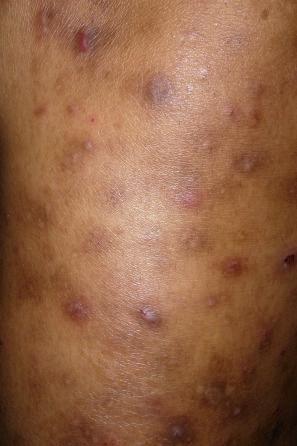
Whether PPE is a distinct entity or whether it is part of the spectrum of eosinophilic folliculitis remains controversial. Unproven pathogenetic theories include the role of infections ( Staphylococcus aureus , Demodex folliculorum , and Sarcoptes scabiei ), drug eruptions, a direct HIV effect, pemphigoid-like autoimmunity, and a primary abnormality of the pilosebaceous unit. The relationship between mosquito bites and PPE is complex. Proposed mechanisms include the hypothesis that the individual lesions in PPE represent mosquito bites, or that the eruption represents a generalized hypersensitivity reaction to mosquito saliva, similar to papular urticaria. A study has highlighted the role of arthropod bites, mainly those of the mosquito, in the pathogenesis of PPE, emphasizing that PPE represents an exaggerated immune response to arthropod antigens in predisposed HIV-infected patients. Increased concentrations of interleukin-2, interleukin-12, δ-interferon, and interleukin-5, in association with a decreased CD4-positive T-lymphocyte count in the blood and increased CD8-positive T lymphocytes in lesional skin, are hypothesized to explain the occurrence of a mixed Th1/Th2 or Th0 pattern, leading to cytokine production and an influx of eosinophils in the cutaneous infiltrate.
The histologic features vary, depending on whether older, scarred, and excoriated nodules or new lesions are biopsied. The early lesions demonstrate a moderately dense to dense, superficial, and deep, perivascular, perifollicular, perieccrine, and interstitial infiltrate of lymphocytes and eosinophils, with variable extension into the subcutis, and epidermal hyperplasia ( Figs 19.19 and 19.20 ). There is a predominance of CD8-positive T lymphocytes. Healed lesions demonstrate variable scarring and postinflammatory hyperpigmentation. Long-standing nodular lesions that are the result of chronic pruritus and excoriation show histologic features of prurigo nodularis.
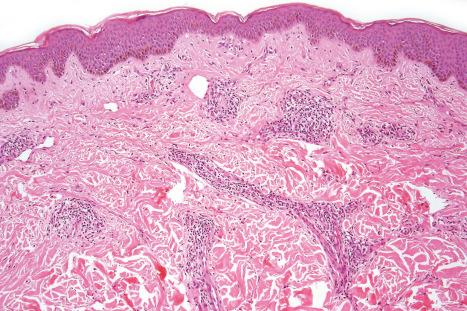
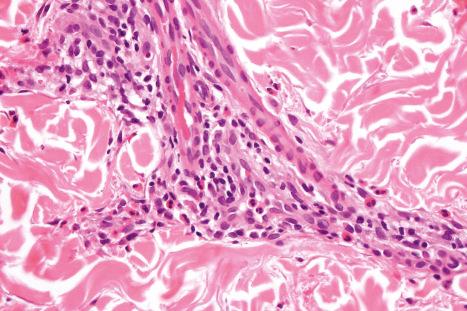
Become a Clinical Tree membership for Full access and enjoy Unlimited articles
If you are a member. Log in here